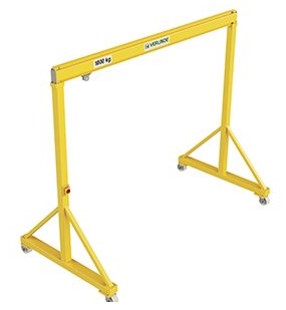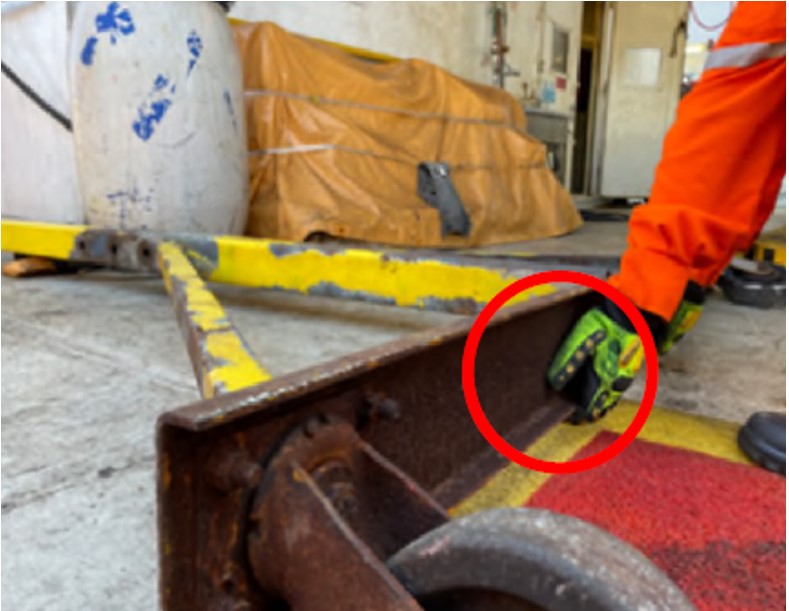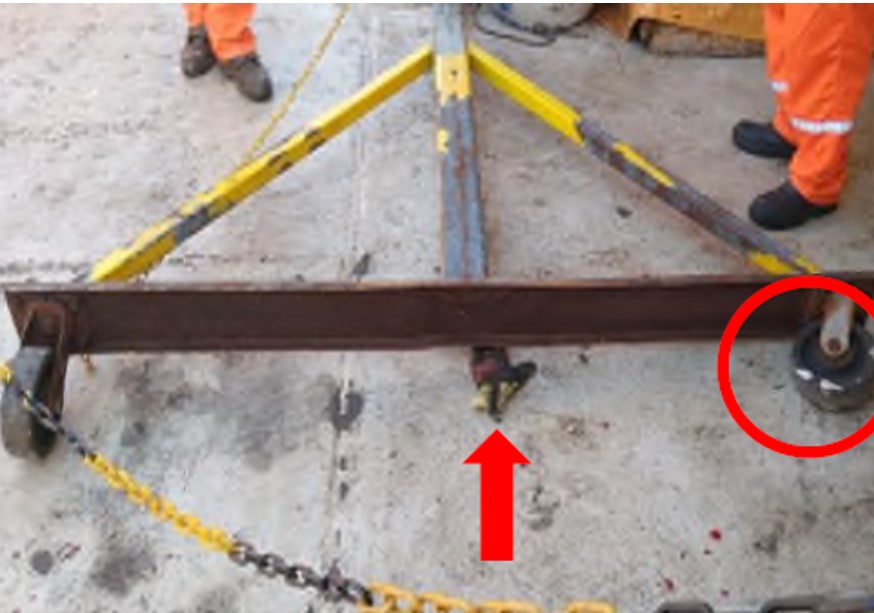LTI: finger crushed while moving mobile gantry crane
What happened
A crew member suffered a crushed index finger during manual handling of heavy equipment. The bosun, the deck supervisor and two others were working on disassembling the mobile gantry crane to move it to another location. They successfully took the gantry to pieces and manually moved one of the support legs. They decided to use a pallet trolley to shift the second support leg. They found that they could not get the second support leg (on the pallet trolley) past the first support leg which was blocking the way. So, the deck team attempted to manually reposition the first support leg.
The injured person (the bosun) started dragging the first support leg, without waiting for help, by grabbing its base from below. As he did so, a vertically positioned wheel turned, causing the support leg to collapse onto his finger and crush it against the deck. First aid was provided and the bosun had to be medevaced for further treatment ashore.
Right: Mobile gantry crane
(image: www.hoistuk.com/products/portable-mobile-gantry/)



What went wrong
- There was inadequate planning, lack of communication, lack of supervision, and lack of experience in handling manual loads;
- Company procedures were not followed: the Risk Assessment was inadequate. No account was taken of:
- The weight of the gantry;
- How many people would be needed to move it safely;
- The technique to be used and the route through which the loads would be moved.
- No-one stopped the job – “What are we doing here? Let’s just stop a moment and re-assess the situation…”
- There was insufficient safety awareness of the considerable “line of fire” risks faced – no attention was paid to the pinch point risk.
Actions taken
- The company discontinued the use of this very heavy steel mobile gantry crane with no safety locks on the wheels, and replaced it with a new, much lighter Aluminium mobile gantry crane with wheel safety locks;
- Easier access between port and starboard deck areas was created by modifying (extending) the height of cable tray pipes to avoid the necessity of assembling/disassembling of the gantry crane before movement;
- Re-emphasised crew training on Permit to Work and Risk Assessment – with particular emphasis on identifying the Hazards related to Pinch Points;
- Conducted further training with on-board leadership on the importance of applying safety tools such as toolbox talks, “step back and take 5”, stop work policy, etc.
Members may wish to refer to:
- Fatal incident during change-out of chain wheel (gypsy) on anchor handling tug supply (AHTS) vessel [Contributing factors were inadequate design for this task, and insufficient lifting or handling appliances for the task]
- Finger injury during maintenance work – restricted work case [no-one stopped the job; they carried on with an unplanned – and hazardous – solution to a problem]
- Fractured finger while handling metal plates [the task was unsafe by design; there were generic risk assessment, and manual handling was not properly risk assessed at all]
Safety Event
Published: 16 February 2023
Download: IMCA SF 05/23
IMCA Safety Flashes
Submit a Report
IMCA Safety Flashes summarise key safety matters and incidents, allowing lessons to be more easily learnt for the benefit of all. The effectiveness of the IMCA Safety Flash system depends on Members sharing information and so avoiding repeat incidents. Please consider adding [email protected] to your internal distribution list for safety alerts or manually submitting information on incidents you consider may be relevant. All information is anonymised or sanitised, as appropriate.
IMCA’s store terms and conditions (https://www.imca-int.com/legal-notices/terms/) apply to all downloads from IMCA’s website, including this document.
IMCA makes every effort to ensure the accuracy and reliability of the data contained in the documents it publishes, but IMCA shall not be liable for any guidance and/or recommendation and/or statement herein contained. The information contained in this document does not fulfil or replace any individual’s or Member's legal, regulatory or other duties or obligations in respect of their operations. Individuals and Members remain solely responsible for the safe, lawful and proper conduct of their operations.
